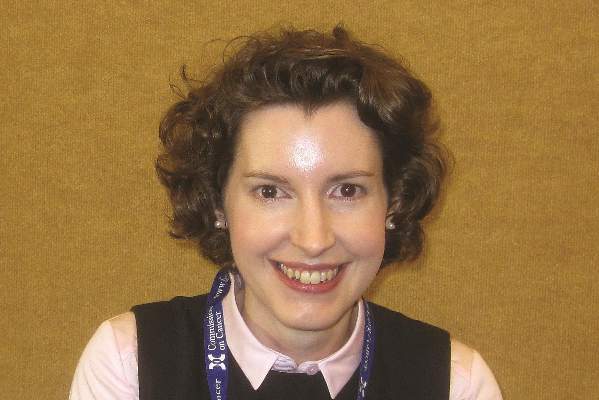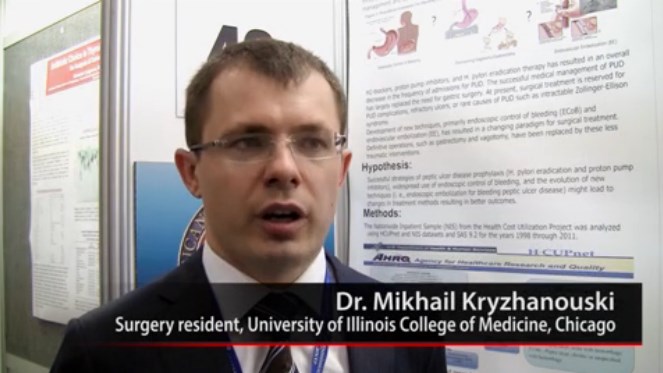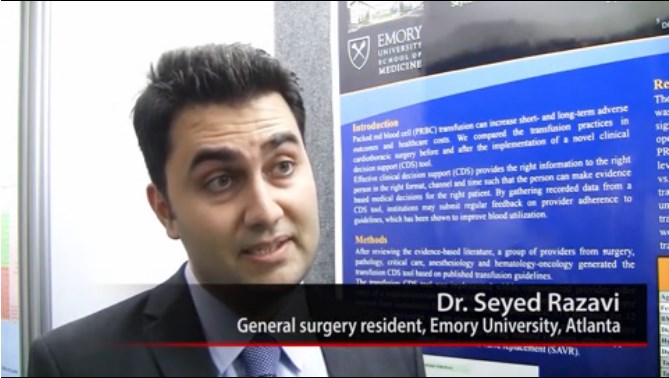User login
M. Alexander Otto began his reporting career early in 1999 covering the pharmaceutical industry for a national pharmacists' magazine and freelancing for the Washington Post and other newspapers. He then joined BNA, now part of Bloomberg News, covering health law and the protection of people and animals in medical research. Alex next worked for the McClatchy Company. Based on his work, Alex won a year-long Knight Science Journalism Fellowship to MIT in 2008-2009. He joined the company shortly thereafter. Alex has a newspaper journalism degree from Syracuse (N.Y.) University and a master's degree in medical science -- a physician assistant degree -- from George Washington University. Alex is based in Seattle.
Low-stage colon cancers need to be followed post surgery for recurrence
SAN FRANCISCO – Patients with stage I colorectal cancer should be followed as closely as patients with higher-stage primary tumors after resection, according to a prospective 6-year surveillance study of 1,202 British patients.
The reason is that the incidence of recurrences that can be treated surgically with curative intent is the same in stage I patients as it is in patients with stage II and III primaries, about 6% (J. Am. Coll. Surg. 2014:219;e46-47).
Following resection with clear margins, the patients were randomized about 300 per group to either serial CT surveillance, serial carcinoembryonic antigen (CEA) monitoring, both, or minimum surveillance, and followed for a median of 4.4 years. About a quarter of the subjects had Dukes’ A primaries and a quarter Dukes’ C primaries, and about half had Dukes’ B primaries. The A, B, C designations are similar to the stage I, II, and III designations more common in the United States.
On both sides of the Atlantic, guidelines focus on active surveillance for higher-stage primaries, but are ambivalent about monitoring stage I tumors because they are less likely to recur and the benefit of follow-up has been uncertain.
That needs to change because treatable recurrences are what matters, and they are as likely in low-stage disease as in high-stage disease, lead investigator Dr. Sian Pugh, a colorectal surgeon at the University of Southampton (England), said at the annual clinical congress of the American College of Surgeons.
“Picking up recurrences that are not treatable doesn’t help anyone; it just gives you bad news earlier,” she said. The benefit of follow-up is “finding treatable disease, and that’s independent of the stage of the primary tumor. We recommend equivalent follow-up for all patients with resected Dukes’ A-C colorectal cancer. The guidelines [should] be reconsidered,” she asserted.
Her team also thinks that the most cost-effective way to monitor patients is probably with CEA monitoring every 3 months for the first 2 years, CEA monitoring every 6 months thereafter until year 5, and a single CT at 12-18 months to catch recurrences that don’t express CEA. That strategy was three times more likely than minimal surveillance to find treatable recurrences, about the same as serial CTs and serial CTs with regular CEA monitoring.
“We don’t think patients need to be followed up quite as intensively as the guidelines suggest,” – for instance, CT scans every 6 months – “but we are waiting for more health economic analysis,” Dr. Pugh said.
Although treatable recurrences were equally likely in all the groups, they were more common in patients with lower-stage primary cancers. Among recurrences in patients with Dukes’ A primary tumors, 50% (13/26) were treated surgically with curative intent, compared with 40% (32/81) in patients with Dukes’ B primaries and 24% (20/82) in those with Dukes’ C.
Pulmonary recurrence was most frequent with rectal primary tumors, and multisite recurrence was most common from right-colonic cancers. Median survival following recurrence was 2.28 years and was influenced by stage and site of primary. Following recurrence, survival was highest in those with lower-stage and rectal primaries, and lowest in patients with higher-stage primaries and recurrence from the right colon.
Dr. Pugh had no disclosures. The work was funded by the U.K. National Health Service.
There’s a lot of heterogeneity in the United States with regard to how frequently people get surveillance imaging and CEA for colon cancer recurrence. The study is helpful because it presents data that inform the decision.
These data suggest that CEA on a regular basis and a CT scan at 1 year are enough. This may be a more rational, cost-effective way to screen people and still achieve what we’re trying to achieve: picking up treatable recurrences.
Dr. Timothy Pawlik is chief of the division of surgical oncology and a professor of surgery at Johns Hopkins University, Baltimore.
There’s a lot of heterogeneity in the United States with regard to how frequently people get surveillance imaging and CEA for colon cancer recurrence. The study is helpful because it presents data that inform the decision.
These data suggest that CEA on a regular basis and a CT scan at 1 year are enough. This may be a more rational, cost-effective way to screen people and still achieve what we’re trying to achieve: picking up treatable recurrences.
Dr. Timothy Pawlik is chief of the division of surgical oncology and a professor of surgery at Johns Hopkins University, Baltimore.
There’s a lot of heterogeneity in the United States with regard to how frequently people get surveillance imaging and CEA for colon cancer recurrence. The study is helpful because it presents data that inform the decision.
These data suggest that CEA on a regular basis and a CT scan at 1 year are enough. This may be a more rational, cost-effective way to screen people and still achieve what we’re trying to achieve: picking up treatable recurrences.
Dr. Timothy Pawlik is chief of the division of surgical oncology and a professor of surgery at Johns Hopkins University, Baltimore.
SAN FRANCISCO – Patients with stage I colorectal cancer should be followed as closely as patients with higher-stage primary tumors after resection, according to a prospective 6-year surveillance study of 1,202 British patients.
The reason is that the incidence of recurrences that can be treated surgically with curative intent is the same in stage I patients as it is in patients with stage II and III primaries, about 6% (J. Am. Coll. Surg. 2014:219;e46-47).
Following resection with clear margins, the patients were randomized about 300 per group to either serial CT surveillance, serial carcinoembryonic antigen (CEA) monitoring, both, or minimum surveillance, and followed for a median of 4.4 years. About a quarter of the subjects had Dukes’ A primaries and a quarter Dukes’ C primaries, and about half had Dukes’ B primaries. The A, B, C designations are similar to the stage I, II, and III designations more common in the United States.
On both sides of the Atlantic, guidelines focus on active surveillance for higher-stage primaries, but are ambivalent about monitoring stage I tumors because they are less likely to recur and the benefit of follow-up has been uncertain.
That needs to change because treatable recurrences are what matters, and they are as likely in low-stage disease as in high-stage disease, lead investigator Dr. Sian Pugh, a colorectal surgeon at the University of Southampton (England), said at the annual clinical congress of the American College of Surgeons.
“Picking up recurrences that are not treatable doesn’t help anyone; it just gives you bad news earlier,” she said. The benefit of follow-up is “finding treatable disease, and that’s independent of the stage of the primary tumor. We recommend equivalent follow-up for all patients with resected Dukes’ A-C colorectal cancer. The guidelines [should] be reconsidered,” she asserted.
Her team also thinks that the most cost-effective way to monitor patients is probably with CEA monitoring every 3 months for the first 2 years, CEA monitoring every 6 months thereafter until year 5, and a single CT at 12-18 months to catch recurrences that don’t express CEA. That strategy was three times more likely than minimal surveillance to find treatable recurrences, about the same as serial CTs and serial CTs with regular CEA monitoring.
“We don’t think patients need to be followed up quite as intensively as the guidelines suggest,” – for instance, CT scans every 6 months – “but we are waiting for more health economic analysis,” Dr. Pugh said.
Although treatable recurrences were equally likely in all the groups, they were more common in patients with lower-stage primary cancers. Among recurrences in patients with Dukes’ A primary tumors, 50% (13/26) were treated surgically with curative intent, compared with 40% (32/81) in patients with Dukes’ B primaries and 24% (20/82) in those with Dukes’ C.
Pulmonary recurrence was most frequent with rectal primary tumors, and multisite recurrence was most common from right-colonic cancers. Median survival following recurrence was 2.28 years and was influenced by stage and site of primary. Following recurrence, survival was highest in those with lower-stage and rectal primaries, and lowest in patients with higher-stage primaries and recurrence from the right colon.
Dr. Pugh had no disclosures. The work was funded by the U.K. National Health Service.
SAN FRANCISCO – Patients with stage I colorectal cancer should be followed as closely as patients with higher-stage primary tumors after resection, according to a prospective 6-year surveillance study of 1,202 British patients.
The reason is that the incidence of recurrences that can be treated surgically with curative intent is the same in stage I patients as it is in patients with stage II and III primaries, about 6% (J. Am. Coll. Surg. 2014:219;e46-47).
Following resection with clear margins, the patients were randomized about 300 per group to either serial CT surveillance, serial carcinoembryonic antigen (CEA) monitoring, both, or minimum surveillance, and followed for a median of 4.4 years. About a quarter of the subjects had Dukes’ A primaries and a quarter Dukes’ C primaries, and about half had Dukes’ B primaries. The A, B, C designations are similar to the stage I, II, and III designations more common in the United States.
On both sides of the Atlantic, guidelines focus on active surveillance for higher-stage primaries, but are ambivalent about monitoring stage I tumors because they are less likely to recur and the benefit of follow-up has been uncertain.
That needs to change because treatable recurrences are what matters, and they are as likely in low-stage disease as in high-stage disease, lead investigator Dr. Sian Pugh, a colorectal surgeon at the University of Southampton (England), said at the annual clinical congress of the American College of Surgeons.
“Picking up recurrences that are not treatable doesn’t help anyone; it just gives you bad news earlier,” she said. The benefit of follow-up is “finding treatable disease, and that’s independent of the stage of the primary tumor. We recommend equivalent follow-up for all patients with resected Dukes’ A-C colorectal cancer. The guidelines [should] be reconsidered,” she asserted.
Her team also thinks that the most cost-effective way to monitor patients is probably with CEA monitoring every 3 months for the first 2 years, CEA monitoring every 6 months thereafter until year 5, and a single CT at 12-18 months to catch recurrences that don’t express CEA. That strategy was three times more likely than minimal surveillance to find treatable recurrences, about the same as serial CTs and serial CTs with regular CEA monitoring.
“We don’t think patients need to be followed up quite as intensively as the guidelines suggest,” – for instance, CT scans every 6 months – “but we are waiting for more health economic analysis,” Dr. Pugh said.
Although treatable recurrences were equally likely in all the groups, they were more common in patients with lower-stage primary cancers. Among recurrences in patients with Dukes’ A primary tumors, 50% (13/26) were treated surgically with curative intent, compared with 40% (32/81) in patients with Dukes’ B primaries and 24% (20/82) in those with Dukes’ C.
Pulmonary recurrence was most frequent with rectal primary tumors, and multisite recurrence was most common from right-colonic cancers. Median survival following recurrence was 2.28 years and was influenced by stage and site of primary. Following recurrence, survival was highest in those with lower-stage and rectal primaries, and lowest in patients with higher-stage primaries and recurrence from the right colon.
Dr. Pugh had no disclosures. The work was funded by the U.K. National Health Service.
Key clinical point: The incidence of treatable recurrence is the same regardless of the stage of the primary colon tumor.
Major finding: Six percent of recurrent stage I, II, and III colon cancers can be treated surgically with curative intent.
Data source: Randomized surveillance study of 1,202 British colon cancer patients after removal of their primary tumors.
Disclosures: Dr. Pugh had no disclosures. The work was funded by the U.K. National Health Service.
VIDEO: How to halve serious reportable events in the OR
SAN FRANCISCO– Little steps, when added together, lead to big reductions in serious reportable events in the operating room, according to investigators from the Phoenix-based Banner Health system.
After slight modifications to the count, timeout, and other OR procedures, Banner saw a 52% reduction in serious reportable events (SREs), including a 70% reduction in wrong-site surgeries, across its 22 hospitals and 8 ambulatory surgery centers (J. Am. Coll. Surg. 2014 Oct. 4 [doi:http://dx.doi.org/10.1016/j.jamcollsurg.2014.09.018]).
In an interview at the annual clinical congress of the American College of Surgeons, lead investigator Dr. Terrence Loftus, the health system’s medical director of surgery services and clinical resources, explained how they did it. He also explained why surgical SREs are seven times more common in the system’s robotic surgery program, despite overall improvements, and what Banner is planning to do about it.
The video associated with this article is no longer available on this site. Please view all of our videos on the MDedge YouTube channel
SAN FRANCISCO– Little steps, when added together, lead to big reductions in serious reportable events in the operating room, according to investigators from the Phoenix-based Banner Health system.
After slight modifications to the count, timeout, and other OR procedures, Banner saw a 52% reduction in serious reportable events (SREs), including a 70% reduction in wrong-site surgeries, across its 22 hospitals and 8 ambulatory surgery centers (J. Am. Coll. Surg. 2014 Oct. 4 [doi:http://dx.doi.org/10.1016/j.jamcollsurg.2014.09.018]).
In an interview at the annual clinical congress of the American College of Surgeons, lead investigator Dr. Terrence Loftus, the health system’s medical director of surgery services and clinical resources, explained how they did it. He also explained why surgical SREs are seven times more common in the system’s robotic surgery program, despite overall improvements, and what Banner is planning to do about it.
The video associated with this article is no longer available on this site. Please view all of our videos on the MDedge YouTube channel
SAN FRANCISCO– Little steps, when added together, lead to big reductions in serious reportable events in the operating room, according to investigators from the Phoenix-based Banner Health system.
After slight modifications to the count, timeout, and other OR procedures, Banner saw a 52% reduction in serious reportable events (SREs), including a 70% reduction in wrong-site surgeries, across its 22 hospitals and 8 ambulatory surgery centers (J. Am. Coll. Surg. 2014 Oct. 4 [doi:http://dx.doi.org/10.1016/j.jamcollsurg.2014.09.018]).
In an interview at the annual clinical congress of the American College of Surgeons, lead investigator Dr. Terrence Loftus, the health system’s medical director of surgery services and clinical resources, explained how they did it. He also explained why surgical SREs are seven times more common in the system’s robotic surgery program, despite overall improvements, and what Banner is planning to do about it.
The video associated with this article is no longer available on this site. Please view all of our videos on the MDedge YouTube channel
AT THE ACS CLINICAL CONGRESS
VIDEO: How to meet ACA goals through electronic consultations
SAN FRANCISCO – To meet the Affordable Care Act’s goal of integrated health care, access to mental health services is going to have to improve, according to Dr. Roderick E. Shaner, medical director of the Los Angeles County Department of Mental Health.
That’s going to mean more electronic consultations with primary care providers needing advice, in addition to traditional face-to-face meetings with patients.
At the American Psychiatric Association’s Institute on Psychiatric Services meeting, Dr. Shaner shared what his county has learned so far about implementing the ACA, and insights about how his psychiatrists are paid for their electronic consultations.
The video associated with this article is no longer available on this site. Please view all of our videos on the MDedge YouTube channel
SAN FRANCISCO – To meet the Affordable Care Act’s goal of integrated health care, access to mental health services is going to have to improve, according to Dr. Roderick E. Shaner, medical director of the Los Angeles County Department of Mental Health.
That’s going to mean more electronic consultations with primary care providers needing advice, in addition to traditional face-to-face meetings with patients.
At the American Psychiatric Association’s Institute on Psychiatric Services meeting, Dr. Shaner shared what his county has learned so far about implementing the ACA, and insights about how his psychiatrists are paid for their electronic consultations.
The video associated with this article is no longer available on this site. Please view all of our videos on the MDedge YouTube channel
SAN FRANCISCO – To meet the Affordable Care Act’s goal of integrated health care, access to mental health services is going to have to improve, according to Dr. Roderick E. Shaner, medical director of the Los Angeles County Department of Mental Health.
That’s going to mean more electronic consultations with primary care providers needing advice, in addition to traditional face-to-face meetings with patients.
At the American Psychiatric Association’s Institute on Psychiatric Services meeting, Dr. Shaner shared what his county has learned so far about implementing the ACA, and insights about how his psychiatrists are paid for their electronic consultations.
The video associated with this article is no longer available on this site. Please view all of our videos on the MDedge YouTube channel
AT INSTITUTE ON PSYCHIATRIC SERVICES
VIDEO: Less trauma, more success with bleeding peptic ulcer management
SAN FRANCISCO – If current trends continue, vagotomy and gastrectomy for bleeding peptic ulcers will be mostly a thing of the past, according to Dr. Mikhail Kryzhanouski, a surgery resident at the University of Illinois, Chicago.
Their use is quickly fading, eclipsed by better techniques and a steady drop in adverse outcomes, even though patients are presenting with more comorbidities, Dr. Kryzhanouski found in a review of patients in the U.S. Nationwide Inpatient Sample who were hospitalized for peptic ulcers from 1998 to 2011 (J. Am. Coll. Surg. 2014;219:e142).
Dr. Kryzhanouski shared the results of his study – and the reasons for his prediction – at the American College of Surgeons Clinical Congress.
The video associated with this article is no longer available on this site. Please view all of our videos on the MDedge YouTube channel
SAN FRANCISCO – If current trends continue, vagotomy and gastrectomy for bleeding peptic ulcers will be mostly a thing of the past, according to Dr. Mikhail Kryzhanouski, a surgery resident at the University of Illinois, Chicago.
Their use is quickly fading, eclipsed by better techniques and a steady drop in adverse outcomes, even though patients are presenting with more comorbidities, Dr. Kryzhanouski found in a review of patients in the U.S. Nationwide Inpatient Sample who were hospitalized for peptic ulcers from 1998 to 2011 (J. Am. Coll. Surg. 2014;219:e142).
Dr. Kryzhanouski shared the results of his study – and the reasons for his prediction – at the American College of Surgeons Clinical Congress.
The video associated with this article is no longer available on this site. Please view all of our videos on the MDedge YouTube channel
SAN FRANCISCO – If current trends continue, vagotomy and gastrectomy for bleeding peptic ulcers will be mostly a thing of the past, according to Dr. Mikhail Kryzhanouski, a surgery resident at the University of Illinois, Chicago.
Their use is quickly fading, eclipsed by better techniques and a steady drop in adverse outcomes, even though patients are presenting with more comorbidities, Dr. Kryzhanouski found in a review of patients in the U.S. Nationwide Inpatient Sample who were hospitalized for peptic ulcers from 1998 to 2011 (J. Am. Coll. Surg. 2014;219:e142).
Dr. Kryzhanouski shared the results of his study – and the reasons for his prediction – at the American College of Surgeons Clinical Congress.
The video associated with this article is no longer available on this site. Please view all of our videos on the MDedge YouTube channel
AT THE AMERICAN COLLEGE OF SURGEONS CLINICAL CONGRESS
VIDEO: An easy way to improve breast biopsy practices
SAN FRANCISCO – Surgeons improve if they know they are behind the curve, according to Dr. Judy A. Tjoe, a breast cancer surgeon with Milwaukee-based Aurora Health Care.
She and her colleagues used that principle to significantly increase Aurora’s use of minimally invasive breast biopsies, the gold standard to diagnose breast cancer.
Although Dr. Tjoe and the system’s other three dedicated breast surgeons were using MIBB as appropriate, they found that 9 of 42 general surgeons (21%) were not, opting instead for open biopsies.
All it took to fix the problem was letting those surgeons know that minimally invasive breast biopsies was the preferred method, and that most of their peers were using it.
In a video interview at the American College of Surgeons Clinical Congress, Dr. Tjoe, also chair of Aurora’s quality committee for breast cancer care, explained why that message was so powerful, and how, in an era of pay for performance, the project is a model for improving health care without punitive measures.
The video associated with this article is no longer available on this site. Please view all of our videos on the MDedge YouTube channel
SAN FRANCISCO – Surgeons improve if they know they are behind the curve, according to Dr. Judy A. Tjoe, a breast cancer surgeon with Milwaukee-based Aurora Health Care.
She and her colleagues used that principle to significantly increase Aurora’s use of minimally invasive breast biopsies, the gold standard to diagnose breast cancer.
Although Dr. Tjoe and the system’s other three dedicated breast surgeons were using MIBB as appropriate, they found that 9 of 42 general surgeons (21%) were not, opting instead for open biopsies.
All it took to fix the problem was letting those surgeons know that minimally invasive breast biopsies was the preferred method, and that most of their peers were using it.
In a video interview at the American College of Surgeons Clinical Congress, Dr. Tjoe, also chair of Aurora’s quality committee for breast cancer care, explained why that message was so powerful, and how, in an era of pay for performance, the project is a model for improving health care without punitive measures.
The video associated with this article is no longer available on this site. Please view all of our videos on the MDedge YouTube channel
SAN FRANCISCO – Surgeons improve if they know they are behind the curve, according to Dr. Judy A. Tjoe, a breast cancer surgeon with Milwaukee-based Aurora Health Care.
She and her colleagues used that principle to significantly increase Aurora’s use of minimally invasive breast biopsies, the gold standard to diagnose breast cancer.
Although Dr. Tjoe and the system’s other three dedicated breast surgeons were using MIBB as appropriate, they found that 9 of 42 general surgeons (21%) were not, opting instead for open biopsies.
All it took to fix the problem was letting those surgeons know that minimally invasive breast biopsies was the preferred method, and that most of their peers were using it.
In a video interview at the American College of Surgeons Clinical Congress, Dr. Tjoe, also chair of Aurora’s quality committee for breast cancer care, explained why that message was so powerful, and how, in an era of pay for performance, the project is a model for improving health care without punitive measures.
The video associated with this article is no longer available on this site. Please view all of our videos on the MDedge YouTube channel
AT THE AMERICAN COLLEGE OF SURGEONS CLINICAL CONGRESS
VIDEO: EMR reminder reduces unnecessary transfusions
SAN FRANCISCO – To reduce unnecessary transfusions, all it takes is a reminder in the electronic medical record system that they aren’t generally necessary if surgery patients have hemoglobins greater than 10 g/dL, according to investigators from Emory University in Atlanta.
A reminder in Emory’s EMR dropped transfusion rates in cardiothoracic patients without increasing negative outcomes. It also saved money and reduced the number of surgical site infections. Emory is now rolling it out systemwide (J. Am. Coll. Surg. 2014 June 25 [doi: 10.1016/j.jamcollsurg.2014.06.012]). Lead investigator Dr. Seyed Razavi explained the initiative in a video interview at the annual clinical congress of the American College of Surgeons.
The video associated with this article is no longer available on this site. Please view all of our videos on the MDedge YouTube channel
Dr. Hossein Almassi, FCCP, comments: By their nature, cardiac operations are associated with higher transfusion rates than other surgical procedures. The negative impact of blood transfusion on short term hospital outcomes and mortality is well known. Any effort in reducing the adverse outcomes is a step in the right direction, especially in this era of 'pay per performance". A "reminder in the EMR" is but one such step.
Dr. Almassi specializes in cardiothoracic surgery at the Medical College of Wisconsin in Milwaukee, Wisconsin.
Dr. Hossein Almassi, FCCP, comments: By their nature, cardiac operations are associated with higher transfusion rates than other surgical procedures. The negative impact of blood transfusion on short term hospital outcomes and mortality is well known. Any effort in reducing the adverse outcomes is a step in the right direction, especially in this era of 'pay per performance". A "reminder in the EMR" is but one such step.
Dr. Almassi specializes in cardiothoracic surgery at the Medical College of Wisconsin in Milwaukee, Wisconsin.
Dr. Hossein Almassi, FCCP, comments: By their nature, cardiac operations are associated with higher transfusion rates than other surgical procedures. The negative impact of blood transfusion on short term hospital outcomes and mortality is well known. Any effort in reducing the adverse outcomes is a step in the right direction, especially in this era of 'pay per performance". A "reminder in the EMR" is but one such step.
Dr. Almassi specializes in cardiothoracic surgery at the Medical College of Wisconsin in Milwaukee, Wisconsin.
SAN FRANCISCO – To reduce unnecessary transfusions, all it takes is a reminder in the electronic medical record system that they aren’t generally necessary if surgery patients have hemoglobins greater than 10 g/dL, according to investigators from Emory University in Atlanta.
A reminder in Emory’s EMR dropped transfusion rates in cardiothoracic patients without increasing negative outcomes. It also saved money and reduced the number of surgical site infections. Emory is now rolling it out systemwide (J. Am. Coll. Surg. 2014 June 25 [doi: 10.1016/j.jamcollsurg.2014.06.012]). Lead investigator Dr. Seyed Razavi explained the initiative in a video interview at the annual clinical congress of the American College of Surgeons.
The video associated with this article is no longer available on this site. Please view all of our videos on the MDedge YouTube channel
SAN FRANCISCO – To reduce unnecessary transfusions, all it takes is a reminder in the electronic medical record system that they aren’t generally necessary if surgery patients have hemoglobins greater than 10 g/dL, according to investigators from Emory University in Atlanta.
A reminder in Emory’s EMR dropped transfusion rates in cardiothoracic patients without increasing negative outcomes. It also saved money and reduced the number of surgical site infections. Emory is now rolling it out systemwide (J. Am. Coll. Surg. 2014 June 25 [doi: 10.1016/j.jamcollsurg.2014.06.012]). Lead investigator Dr. Seyed Razavi explained the initiative in a video interview at the annual clinical congress of the American College of Surgeons.
The video associated with this article is no longer available on this site. Please view all of our videos on the MDedge YouTube channel
AT THE ACS CLINICAL CONGRESS
VIDEO: Lamivudine under study for Ebola
SAN FRANCISCO– It’s possible that the HIV drug lamivudine (Epivir) truly is helpful for Ebola, according to epidemiologist George W. Rutherford, head of the division of prevention medicine and public health at the University of California, San Francisco.
He and his colleagues are gearing up to study the drug, in the wake of anecdotal reports suggesting that it might help. In vitro testing for Ebola is already underway.
In this video interview, Dr. Rutherford shares his thoughts on the drug as a treatment for the infection. He also explains the current thinking on another potential Ebola treatment, ZMapp, at the American Psychiatric Association Institute on Psychiatric Services meeting.
The video associated with this article is no longer available on this site. Please view all of our videos on the MDedge YouTube channel
SAN FRANCISCO– It’s possible that the HIV drug lamivudine (Epivir) truly is helpful for Ebola, according to epidemiologist George W. Rutherford, head of the division of prevention medicine and public health at the University of California, San Francisco.
He and his colleagues are gearing up to study the drug, in the wake of anecdotal reports suggesting that it might help. In vitro testing for Ebola is already underway.
In this video interview, Dr. Rutherford shares his thoughts on the drug as a treatment for the infection. He also explains the current thinking on another potential Ebola treatment, ZMapp, at the American Psychiatric Association Institute on Psychiatric Services meeting.
The video associated with this article is no longer available on this site. Please view all of our videos on the MDedge YouTube channel
SAN FRANCISCO– It’s possible that the HIV drug lamivudine (Epivir) truly is helpful for Ebola, according to epidemiologist George W. Rutherford, head of the division of prevention medicine and public health at the University of California, San Francisco.
He and his colleagues are gearing up to study the drug, in the wake of anecdotal reports suggesting that it might help. In vitro testing for Ebola is already underway.
In this video interview, Dr. Rutherford shares his thoughts on the drug as a treatment for the infection. He also explains the current thinking on another potential Ebola treatment, ZMapp, at the American Psychiatric Association Institute on Psychiatric Services meeting.
The video associated with this article is no longer available on this site. Please view all of our videos on the MDedge YouTube channel
AT THE APA INSTITUTE ON PSYCHIATRIC SERVICES
Larger plasma volumes increase transfusion thrombosis risk
SAN FRANCISCO – Venous thromboembolism is about 50% more likely when trauma patients are transfused with more than 1 unit of fresh frozen plasma for every 2 units of red blood cells, according to a retrospective review of 139,842 adult patients in the National Trauma Data Bank, all of whom received at least 1 unit of red blood cells from 2007 to 2012.
The risk quadrupled when patients received 6 or more red blood cell (RBC) units; for those patients, the only independent risk factor for venous thromboembolism (VTE) was transfusion with more than 1 unit of fresh frozen plasma (FFP) per 2 units of RBCs (odds ratio, 4.12; P = .011).
When patients get that much plasma, they “should be monitored closely for deep vein thrombosis [DVT] and pulmonary embolism [PE], and started on VTE prophylaxis as soon as possible,” said lead investigator Dr. Gregory Magee, a trauma and critical care fellow at the University of Southern California, Los Angeles. The findings complicate an emerging idea of how best to transfuse trauma patients. A 2013 investigation found that 6-hour survival is significantly higher when patients get more plasma with their RBCs than they might have in the past, at least 1 FFP unit for every 2 RBC units. Some research suggests that a 1:1 ratio might be even better (JAMA Surg. 2013;148:127-36). “You need to do what you need to do to help your patients survive,” but there should be a “balancing act to make sure they have enough clotting factors [onboard] to stop the bleeding, but not enough to cause thrombosis,” Dr. Magee said at the annual clinical congress of the American College of Surgeons.
The rate of transfusion-associated PEs in his study was 0.4%, and the rate of DVTs 0.8%. How serious they were is not known; the information was unavailable in the database review. Though low, the incidence of thrombosis increased with increasing volumes of transfused RBCs.
In addition to the 50% increased risk of VTE with higher volumes of transfused plasma (OR 1.47, P < .001), VTE was independently associated with transfusions of 6 or more RBC units (OR 2.10, P = .001); blunt trauma (OR 1.49, P = .001); male gender (OR 1.29, P < .001); and Abbreviated Injury Scale (AIS) scores of 3 or higher for chest injuries (OR 1.30, P < .001), head injuries (OR 1.18, P = .032), and lower extremity injuries (OR 1.16, P = .034).
Several of Dr. Magee’s colleagues are coinvestigators on a recently concluded randomized transfusion trial that pitted plasma, platelet, and RBC ratios of 1:1:1 and 1:1:2 against each other, looking for survival and complication differences. They hope to publish their results soon, he said. The randomized study was the only way to counter the survival bias that might have been at work in the 2013 investigation, which was a prospective cohort study. Higher volumes of plasma might have improved survival, but it’s possible that patients who lived longer were more likely to get FFP, since it’s often administered well after RBC transfusions are underway.
For now, “we don’t know which one is best or if it makes a difference,” Dr. Magee said.
Dr. Magee had no disclosures. The work was funded in part by the National Institutes of Health.
SAN FRANCISCO – Venous thromboembolism is about 50% more likely when trauma patients are transfused with more than 1 unit of fresh frozen plasma for every 2 units of red blood cells, according to a retrospective review of 139,842 adult patients in the National Trauma Data Bank, all of whom received at least 1 unit of red blood cells from 2007 to 2012.
The risk quadrupled when patients received 6 or more red blood cell (RBC) units; for those patients, the only independent risk factor for venous thromboembolism (VTE) was transfusion with more than 1 unit of fresh frozen plasma (FFP) per 2 units of RBCs (odds ratio, 4.12; P = .011).
When patients get that much plasma, they “should be monitored closely for deep vein thrombosis [DVT] and pulmonary embolism [PE], and started on VTE prophylaxis as soon as possible,” said lead investigator Dr. Gregory Magee, a trauma and critical care fellow at the University of Southern California, Los Angeles. The findings complicate an emerging idea of how best to transfuse trauma patients. A 2013 investigation found that 6-hour survival is significantly higher when patients get more plasma with their RBCs than they might have in the past, at least 1 FFP unit for every 2 RBC units. Some research suggests that a 1:1 ratio might be even better (JAMA Surg. 2013;148:127-36). “You need to do what you need to do to help your patients survive,” but there should be a “balancing act to make sure they have enough clotting factors [onboard] to stop the bleeding, but not enough to cause thrombosis,” Dr. Magee said at the annual clinical congress of the American College of Surgeons.
The rate of transfusion-associated PEs in his study was 0.4%, and the rate of DVTs 0.8%. How serious they were is not known; the information was unavailable in the database review. Though low, the incidence of thrombosis increased with increasing volumes of transfused RBCs.
In addition to the 50% increased risk of VTE with higher volumes of transfused plasma (OR 1.47, P < .001), VTE was independently associated with transfusions of 6 or more RBC units (OR 2.10, P = .001); blunt trauma (OR 1.49, P = .001); male gender (OR 1.29, P < .001); and Abbreviated Injury Scale (AIS) scores of 3 or higher for chest injuries (OR 1.30, P < .001), head injuries (OR 1.18, P = .032), and lower extremity injuries (OR 1.16, P = .034).
Several of Dr. Magee’s colleagues are coinvestigators on a recently concluded randomized transfusion trial that pitted plasma, platelet, and RBC ratios of 1:1:1 and 1:1:2 against each other, looking for survival and complication differences. They hope to publish their results soon, he said. The randomized study was the only way to counter the survival bias that might have been at work in the 2013 investigation, which was a prospective cohort study. Higher volumes of plasma might have improved survival, but it’s possible that patients who lived longer were more likely to get FFP, since it’s often administered well after RBC transfusions are underway.
For now, “we don’t know which one is best or if it makes a difference,” Dr. Magee said.
Dr. Magee had no disclosures. The work was funded in part by the National Institutes of Health.
SAN FRANCISCO – Venous thromboembolism is about 50% more likely when trauma patients are transfused with more than 1 unit of fresh frozen plasma for every 2 units of red blood cells, according to a retrospective review of 139,842 adult patients in the National Trauma Data Bank, all of whom received at least 1 unit of red blood cells from 2007 to 2012.
The risk quadrupled when patients received 6 or more red blood cell (RBC) units; for those patients, the only independent risk factor for venous thromboembolism (VTE) was transfusion with more than 1 unit of fresh frozen plasma (FFP) per 2 units of RBCs (odds ratio, 4.12; P = .011).
When patients get that much plasma, they “should be monitored closely for deep vein thrombosis [DVT] and pulmonary embolism [PE], and started on VTE prophylaxis as soon as possible,” said lead investigator Dr. Gregory Magee, a trauma and critical care fellow at the University of Southern California, Los Angeles. The findings complicate an emerging idea of how best to transfuse trauma patients. A 2013 investigation found that 6-hour survival is significantly higher when patients get more plasma with their RBCs than they might have in the past, at least 1 FFP unit for every 2 RBC units. Some research suggests that a 1:1 ratio might be even better (JAMA Surg. 2013;148:127-36). “You need to do what you need to do to help your patients survive,” but there should be a “balancing act to make sure they have enough clotting factors [onboard] to stop the bleeding, but not enough to cause thrombosis,” Dr. Magee said at the annual clinical congress of the American College of Surgeons.
The rate of transfusion-associated PEs in his study was 0.4%, and the rate of DVTs 0.8%. How serious they were is not known; the information was unavailable in the database review. Though low, the incidence of thrombosis increased with increasing volumes of transfused RBCs.
In addition to the 50% increased risk of VTE with higher volumes of transfused plasma (OR 1.47, P < .001), VTE was independently associated with transfusions of 6 or more RBC units (OR 2.10, P = .001); blunt trauma (OR 1.49, P = .001); male gender (OR 1.29, P < .001); and Abbreviated Injury Scale (AIS) scores of 3 or higher for chest injuries (OR 1.30, P < .001), head injuries (OR 1.18, P = .032), and lower extremity injuries (OR 1.16, P = .034).
Several of Dr. Magee’s colleagues are coinvestigators on a recently concluded randomized transfusion trial that pitted plasma, platelet, and RBC ratios of 1:1:1 and 1:1:2 against each other, looking for survival and complication differences. They hope to publish their results soon, he said. The randomized study was the only way to counter the survival bias that might have been at work in the 2013 investigation, which was a prospective cohort study. Higher volumes of plasma might have improved survival, but it’s possible that patients who lived longer were more likely to get FFP, since it’s often administered well after RBC transfusions are underway.
For now, “we don’t know which one is best or if it makes a difference,” Dr. Magee said.
Dr. Magee had no disclosures. The work was funded in part by the National Institutes of Health.
AT THE ACS CLINICAL CONGRESS
Key clinical point: Keep an eye out for VTEs when transfusion ratios go above 1:2 plasma to RBC units, and start prophylaxis against VTEs when it becomes safe to do so.
Major finding: Venous thromboembolism is about 50% more likely when trauma patients are transfused with more than 1 unit of fresh frozen plasma for every 2 units of red blood cells (odds ratio,1.47; P < .001).
Data source: Retrospective review of 139,842 adult patients in the National Trauma Data Bank.
Disclosures: The lead investigator has no disclosures. The work was funded in part by the National Institutes of Health.
Vulvar pruritus in young girls usually due to toilet hygiene
NEWPORT BEACH, CALIF. – All it takes to clear up vulvar pruritus in most young girls prior to puberty is a little reminder about proper toilet habits, according to Dr. Bethanee J. Schlosser.
“There are a whole slew of conditions that cause itching of the genitals in young girls, but the most common is poor hygiene,” explained Dr. Schlosser of the departments of dermatology and obstetrics and gynecology at Northwestern University in Chicago.
Afraid they might miss out on something, children often rush bathroom visits and don’t take the time to wipe properly. Itching and redness soon follow. Gentle guidance is mostly all that’s needed to clear the problem. Loose-fitting cotton underwear helps, too, along with quickly changing soiled underpants, avoiding wet wipes, and taking baths to make sure the genitalia are adequately rinsed, Dr. Schlosser said at the Skin Disease Education Foundation’s Women’s & Pediatric Dermatology Seminar.
Simple as those steps are, they can be overlooked in the clinic. One study found that young girls are sometimes misdiagnosed with candidiasis, and treated with topical antifungals for years, even though yeast infections – the most common cause of vulvovaginal pruritus in adult women – are estrogen dependent, and so far less likely before puberty (Australas. J. Dermatol. 2010;51:118-23). After hygiene issues, lichen sclerosus is perhaps the next most common cause of vulvar pruritus in young girls, and tends to present with more urinary problems and bleeding than in adults, and more GI complaints, especially constipation. It’s “the most common inflammatory vulvar dermatosis that we see, with the possible exception of contact dermatitis,” Dr. Schlosser wrote (Arch. Dermatol. 2004;140:702-6). As in adult women, the first-line treatment is once-daily clobetasol propionate ointment 0.05% for several weeks, followed by maintenance therapy. Dr. Schlosser said she used to switch patients to a less potent topical steroid, but “then I had a couple patients get confused about which tube they were supposed to use at home, so now I taper the frequency of their clobetasol ointment” to once or twice a week instead of switching them to a less potent topical steroid. It’s easier for them, but as with any topical steroid, “you need to continue ongoing monitoring for cutaneous atrophy,” she said.
In general, pelvic exams in pediatric patients “require special consideration. These are not 5-minute visits. You have to take the time to make yourself available. Educate patients and parents about what’s going to happen,” and use the child’s own terms for her genitals, asking parents beforehand what they are, so that the child understands what she’s hearing, Dr. Schlosser said.
“When I see young girls,” mom is in the room and “I only have gauze, gloves, and maybe a Q-tip [swab] here and there. I often” begin by asking the child if it’s okay to look at her scalp, face, and hands, then “gradually work my way down. I think that gives patients some sense of comfort and control,” she said.
Dr. Schlosser said she prefers the frog-leg position, with very young girls in their mothers’ laps. The literature sometimes advocates the prone knee-to-chest position, but “I find it makes people feel very vulnerable. They can’t see you, and they have no idea of what’s going on. I don’t advocate it,” she said.
Dr. Schlosser said she has no relevant financial disclosures.
SDEF and this news organization are owned by Frontline Medical Communications.
NEWPORT BEACH, CALIF. – All it takes to clear up vulvar pruritus in most young girls prior to puberty is a little reminder about proper toilet habits, according to Dr. Bethanee J. Schlosser.
“There are a whole slew of conditions that cause itching of the genitals in young girls, but the most common is poor hygiene,” explained Dr. Schlosser of the departments of dermatology and obstetrics and gynecology at Northwestern University in Chicago.
Afraid they might miss out on something, children often rush bathroom visits and don’t take the time to wipe properly. Itching and redness soon follow. Gentle guidance is mostly all that’s needed to clear the problem. Loose-fitting cotton underwear helps, too, along with quickly changing soiled underpants, avoiding wet wipes, and taking baths to make sure the genitalia are adequately rinsed, Dr. Schlosser said at the Skin Disease Education Foundation’s Women’s & Pediatric Dermatology Seminar.
Simple as those steps are, they can be overlooked in the clinic. One study found that young girls are sometimes misdiagnosed with candidiasis, and treated with topical antifungals for years, even though yeast infections – the most common cause of vulvovaginal pruritus in adult women – are estrogen dependent, and so far less likely before puberty (Australas. J. Dermatol. 2010;51:118-23). After hygiene issues, lichen sclerosus is perhaps the next most common cause of vulvar pruritus in young girls, and tends to present with more urinary problems and bleeding than in adults, and more GI complaints, especially constipation. It’s “the most common inflammatory vulvar dermatosis that we see, with the possible exception of contact dermatitis,” Dr. Schlosser wrote (Arch. Dermatol. 2004;140:702-6). As in adult women, the first-line treatment is once-daily clobetasol propionate ointment 0.05% for several weeks, followed by maintenance therapy. Dr. Schlosser said she used to switch patients to a less potent topical steroid, but “then I had a couple patients get confused about which tube they were supposed to use at home, so now I taper the frequency of their clobetasol ointment” to once or twice a week instead of switching them to a less potent topical steroid. It’s easier for them, but as with any topical steroid, “you need to continue ongoing monitoring for cutaneous atrophy,” she said.
In general, pelvic exams in pediatric patients “require special consideration. These are not 5-minute visits. You have to take the time to make yourself available. Educate patients and parents about what’s going to happen,” and use the child’s own terms for her genitals, asking parents beforehand what they are, so that the child understands what she’s hearing, Dr. Schlosser said.
“When I see young girls,” mom is in the room and “I only have gauze, gloves, and maybe a Q-tip [swab] here and there. I often” begin by asking the child if it’s okay to look at her scalp, face, and hands, then “gradually work my way down. I think that gives patients some sense of comfort and control,” she said.
Dr. Schlosser said she prefers the frog-leg position, with very young girls in their mothers’ laps. The literature sometimes advocates the prone knee-to-chest position, but “I find it makes people feel very vulnerable. They can’t see you, and they have no idea of what’s going on. I don’t advocate it,” she said.
Dr. Schlosser said she has no relevant financial disclosures.
SDEF and this news organization are owned by Frontline Medical Communications.
NEWPORT BEACH, CALIF. – All it takes to clear up vulvar pruritus in most young girls prior to puberty is a little reminder about proper toilet habits, according to Dr. Bethanee J. Schlosser.
“There are a whole slew of conditions that cause itching of the genitals in young girls, but the most common is poor hygiene,” explained Dr. Schlosser of the departments of dermatology and obstetrics and gynecology at Northwestern University in Chicago.
Afraid they might miss out on something, children often rush bathroom visits and don’t take the time to wipe properly. Itching and redness soon follow. Gentle guidance is mostly all that’s needed to clear the problem. Loose-fitting cotton underwear helps, too, along with quickly changing soiled underpants, avoiding wet wipes, and taking baths to make sure the genitalia are adequately rinsed, Dr. Schlosser said at the Skin Disease Education Foundation’s Women’s & Pediatric Dermatology Seminar.
Simple as those steps are, they can be overlooked in the clinic. One study found that young girls are sometimes misdiagnosed with candidiasis, and treated with topical antifungals for years, even though yeast infections – the most common cause of vulvovaginal pruritus in adult women – are estrogen dependent, and so far less likely before puberty (Australas. J. Dermatol. 2010;51:118-23). After hygiene issues, lichen sclerosus is perhaps the next most common cause of vulvar pruritus in young girls, and tends to present with more urinary problems and bleeding than in adults, and more GI complaints, especially constipation. It’s “the most common inflammatory vulvar dermatosis that we see, with the possible exception of contact dermatitis,” Dr. Schlosser wrote (Arch. Dermatol. 2004;140:702-6). As in adult women, the first-line treatment is once-daily clobetasol propionate ointment 0.05% for several weeks, followed by maintenance therapy. Dr. Schlosser said she used to switch patients to a less potent topical steroid, but “then I had a couple patients get confused about which tube they were supposed to use at home, so now I taper the frequency of their clobetasol ointment” to once or twice a week instead of switching them to a less potent topical steroid. It’s easier for them, but as with any topical steroid, “you need to continue ongoing monitoring for cutaneous atrophy,” she said.
In general, pelvic exams in pediatric patients “require special consideration. These are not 5-minute visits. You have to take the time to make yourself available. Educate patients and parents about what’s going to happen,” and use the child’s own terms for her genitals, asking parents beforehand what they are, so that the child understands what she’s hearing, Dr. Schlosser said.
“When I see young girls,” mom is in the room and “I only have gauze, gloves, and maybe a Q-tip [swab] here and there. I often” begin by asking the child if it’s okay to look at her scalp, face, and hands, then “gradually work my way down. I think that gives patients some sense of comfort and control,” she said.
Dr. Schlosser said she prefers the frog-leg position, with very young girls in their mothers’ laps. The literature sometimes advocates the prone knee-to-chest position, but “I find it makes people feel very vulnerable. They can’t see you, and they have no idea of what’s going on. I don’t advocate it,” she said.
Dr. Schlosser said she has no relevant financial disclosures.
SDEF and this news organization are owned by Frontline Medical Communications.
AT THE SDEF WOMEN’S & PEDIATRIC DERMATOLOGY SEMINAR
VIDEO: How to negotiate the robotic surgery learning curve
SAN FRANCISCO– Before attempting robotic surgery, it’s important to be comfortable with both the open and laparoscopic versions of the procedure, according to Dr. Kenneth Meredith, director of robotic surgery at the University of Wisconsin, Madison.
In experienced hands, robotic results can be good. In a case series of 138 robotic-assisted Ivor Lewis esophagectomies at the university for esophageal cancer, the median intensive care unit stay was 2 days and median hospital stay 9 days, Dr. Meredith. Complications occurred in about a quarter of patients.
In a video interview at the American College of Surgeons Clinical Congress, Dr. Meredith explained the significance of the findings and gave tips on how to negotiate the robotic surgery learning curve.
The video associated with this article is no longer available on this site. Please view all of our videos on the MDedge YouTube channel
SAN FRANCISCO– Before attempting robotic surgery, it’s important to be comfortable with both the open and laparoscopic versions of the procedure, according to Dr. Kenneth Meredith, director of robotic surgery at the University of Wisconsin, Madison.
In experienced hands, robotic results can be good. In a case series of 138 robotic-assisted Ivor Lewis esophagectomies at the university for esophageal cancer, the median intensive care unit stay was 2 days and median hospital stay 9 days, Dr. Meredith. Complications occurred in about a quarter of patients.
In a video interview at the American College of Surgeons Clinical Congress, Dr. Meredith explained the significance of the findings and gave tips on how to negotiate the robotic surgery learning curve.
The video associated with this article is no longer available on this site. Please view all of our videos on the MDedge YouTube channel
SAN FRANCISCO– Before attempting robotic surgery, it’s important to be comfortable with both the open and laparoscopic versions of the procedure, according to Dr. Kenneth Meredith, director of robotic surgery at the University of Wisconsin, Madison.
In experienced hands, robotic results can be good. In a case series of 138 robotic-assisted Ivor Lewis esophagectomies at the university for esophageal cancer, the median intensive care unit stay was 2 days and median hospital stay 9 days, Dr. Meredith. Complications occurred in about a quarter of patients.
In a video interview at the American College of Surgeons Clinical Congress, Dr. Meredith explained the significance of the findings and gave tips on how to negotiate the robotic surgery learning curve.
The video associated with this article is no longer available on this site. Please view all of our videos on the MDedge YouTube channel
AT THE AMERICAN COLLEGE OF SURGEONS CLINICAL CONGRESS












